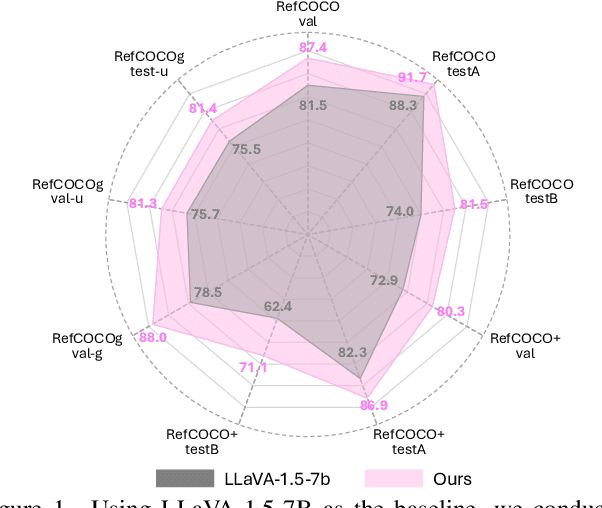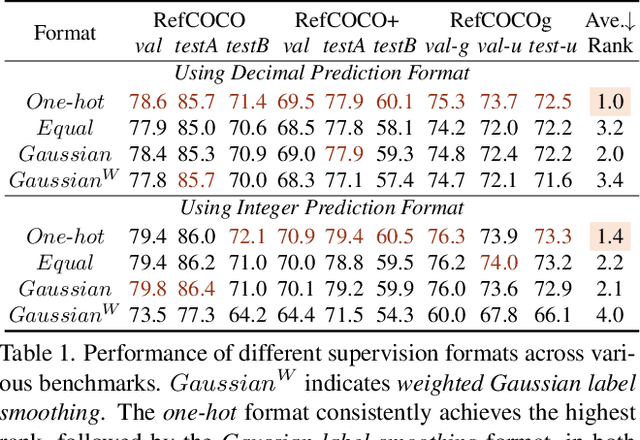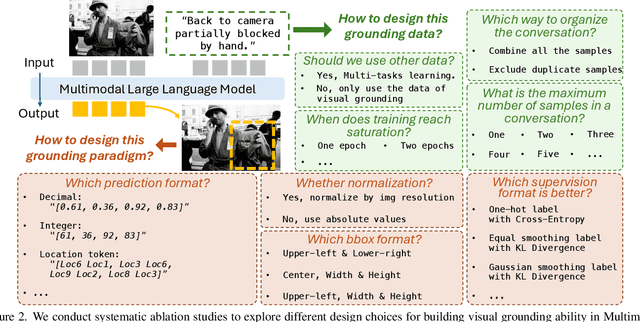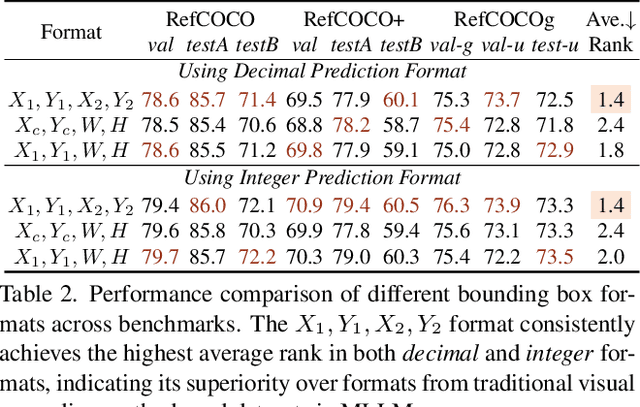Weitai Kang
Investigating the Design Space of Visual Grounding in Multimodal Large Language Model
Aug 11, 2025



Abstract:Fine-grained multimodal capability in Multimodal Large Language Models (MLLMs) has emerged as a critical research direction, particularly for tackling the visual grounding (VG) problem. Despite the strong performance achieved by existing approaches, they often employ disparate design choices when fine-tuning MLLMs for VG, lacking systematic verification to support these designs. To bridge this gap, this paper presents a comprehensive study of various design choices that impact the VG performance of MLLMs. We conduct our analysis using LLaVA-1.5, which has been widely adopted in prior empirical studies of MLLMs. While more recent models exist, we follow this convention to ensure our findings remain broadly applicable and extendable to other architectures. We cover two key aspects: (1) exploring different visual grounding paradigms in MLLMs, identifying the most effective design, and providing our insights; and (2) conducting ablation studies on the design of grounding data to optimize MLLMs' fine-tuning for the VG task. Finally, our findings contribute to a stronger MLLM for VG, achieving improvements of +5.6% / +6.9% / +7.0% on RefCOCO/+/g over the LLaVA-1.5.
InfantAgent-Next: A Multimodal Generalist Agent for Automated Computer Interaction
May 16, 2025Abstract:This paper introduces \textsc{InfantAgent-Next}, a generalist agent capable of interacting with computers in a multimodal manner, encompassing text, images, audio, and video. Unlike existing approaches that either build intricate workflows around a single large model or only provide workflow modularity, our agent integrates tool-based and pure vision agents within a highly modular architecture, enabling different models to collaboratively solve decoupled tasks in a step-by-step manner. Our generality is demonstrated by our ability to evaluate not only pure vision-based real-world benchmarks (i.e., OSWorld), but also more general or tool-intensive benchmarks (e.g., GAIA and SWE-Bench). Specifically, we achieve $\mathbf{7.27\%}$ accuracy on OSWorld, higher than Claude-Computer-Use. Codes and evaluation scripts are open-sourced at https://github.com/bin123apple/InfantAgent.
3DResT: A Strong Baseline for Semi-Supervised 3D Referring Expression Segmentation
Apr 17, 2025Abstract:3D Referring Expression Segmentation (3D-RES) typically requires extensive instance-level annotations, which are time-consuming and costly. Semi-supervised learning (SSL) mitigates this by using limited labeled data alongside abundant unlabeled data, improving performance while reducing annotation costs. SSL uses a teacher-student paradigm where teacher generates high-confidence-filtered pseudo-labels to guide student. However, in the context of 3D-RES, where each label corresponds to a single mask and labeled data is scarce, existing SSL methods treat high-quality pseudo-labels merely as auxiliary supervision, which limits the model's learning potential. The reliance on high-confidence thresholds for filtering often results in potentially valuable pseudo-labels being discarded, restricting the model's ability to leverage the abundant unlabeled data. Therefore, we identify two critical challenges in semi-supervised 3D-RES, namely, inefficient utilization of high-quality pseudo-labels and wastage of useful information from low-quality pseudo-labels. In this paper, we introduce the first semi-supervised learning framework for 3D-RES, presenting a robust baseline method named 3DResT. To address these challenges, we propose two novel designs called Teacher-Student Consistency-Based Sampling (TSCS) and Quality-Driven Dynamic Weighting (QDW). TSCS aids in the selection of high-quality pseudo-labels, integrating them into the labeled dataset to strengthen the labeled supervision signals. QDW preserves low-quality pseudo-labels by dynamically assigning them lower weights, allowing for the effective extraction of useful information rather than discarding them. Extensive experiments conducted on the widely used benchmark demonstrate the effectiveness of our method. Notably, with only 1% labeled data, 3DResT achieves an mIoU improvement of 8.34 points compared to the fully supervised method.
Infant Agent: A Tool-Integrated, Logic-Driven Agent with Cost-Effective API Usage
Nov 02, 2024



Abstract:Despite the impressive capabilities of large language models (LLMs), they currently exhibit two primary limitations, \textbf{\uppercase\expandafter{\romannumeral 1}}: They struggle to \textbf{autonomously solve the real world engineering problem}. \textbf{\uppercase\expandafter{\romannumeral 2}}: They remain \textbf{challenged in reasoning through complex logic problems}. To address these challenges, we developed the \textsc{Infant Agent}, integrating task-aware functions, operators, a hierarchical management system, and a memory retrieval mechanism. Together, these components enable large language models to sustain extended reasoning processes and handle complex, multi-step tasks efficiently, all while significantly reducing API costs. Using the \textsc{Infant Agent}, GPT-4o's accuracy on the SWE-bench-lite dataset rises from $\mathbf{0.33\%}$ to $\mathbf{30\%}$, and in the AIME-2024 mathematics competition, it increases GPT-4o's accuracy from $\mathbf{13.3\%}$ to $\mathbf{37\%}$.
Visual Grounding with Attention-Driven Constraint Balancing
Jul 03, 2024Abstract:Unlike Object Detection, Visual Grounding task necessitates the detection of an object described by complex free-form language. To simultaneously model such complex semantic and visual representations, recent state-of-the-art studies adopt transformer-based models to fuse features from both modalities, further introducing various modules that modulate visual features to align with the language expressions and eliminate the irrelevant redundant information. However, their loss function, still adopting common Object Detection losses, solely governs the bounding box regression output, failing to fully optimize for the above objectives. To tackle this problem, in this paper, we first analyze the attention mechanisms of transformer-based models. Building upon this, we further propose a novel framework named Attention-Driven Constraint Balancing (AttBalance) to optimize the behavior of visual features within language-relevant regions. Extensive experimental results show that our method brings impressive improvements. Specifically, we achieve constant improvements over five different models evaluated on four different benchmarks. Moreover, we attain a new state-of-the-art performance by integrating our method into QRNet.
ACTRESS: Active Retraining for Semi-supervised Visual Grounding
Jul 03, 2024Abstract:Semi-Supervised Visual Grounding (SSVG) is a new challenge for its sparse labeled data with the need for multimodel understanding. A previous study, RefTeacher, makes the first attempt to tackle this task by adopting the teacher-student framework to provide pseudo confidence supervision and attention-based supervision. However, this approach is incompatible with current state-of-the-art visual grounding models, which follow the Transformer-based pipeline. These pipelines directly regress results without region proposals or foreground binary classification, rendering them unsuitable for fitting in RefTeacher due to the absence of confidence scores. Furthermore, the geometric difference in teacher and student inputs, stemming from different data augmentations, induces natural misalignment in attention-based constraints. To establish a compatible SSVG framework, our paper proposes the ACTive REtraining approach for Semi-Supervised Visual Grounding, abbreviated as ACTRESS. Initially, the model is enhanced by incorporating an additional quantized detection head to expose its detection confidence. Building upon this, ACTRESS consists of an active sampling strategy and a selective retraining strategy. The active sampling strategy iteratively selects high-quality pseudo labels by evaluating three crucial aspects: Faithfulness, Robustness, and Confidence, optimizing the utilization of unlabeled data. The selective retraining strategy retrains the model with periodic re-initialization of specific parameters, facilitating the model's escape from local minima. Extensive experiments demonstrates our superior performance on widely-used benchmark datasets.
SegVG: Transferring Object Bounding Box to Segmentation for Visual Grounding
Jul 03, 2024



Abstract:Different from Object Detection, Visual Grounding deals with detecting a bounding box for each text-image pair. This one box for each text-image data provides sparse supervision signals. Although previous works achieve impressive results, their passive utilization of annotation, i.e. the sole use of the box annotation as regression ground truth, results in a suboptimal performance. In this paper, we present SegVG, a novel method transfers the box-level annotation as Segmentation signals to provide an additional pixel-level supervision for Visual Grounding. Specifically, we propose the Multi-layer Multi-task Encoder-Decoder as the target grounding stage, where we learn a regression query and multiple segmentation queries to ground the target by regression and segmentation of the box in each decoding layer, respectively. This approach allows us to iteratively exploit the annotation as signals for both box-level regression and pixel-level segmentation. Moreover, as the backbones are typically initialized by pretrained parameters learned from unimodal tasks and the queries for both regression and segmentation are static learnable embeddings, a domain discrepancy remains among these three types of features, which impairs subsequent target grounding. To mitigate this discrepancy, we introduce the Triple Alignment module, where the query, text, and vision tokens are triangularly updated to share the same space by triple attention mechanism. Extensive experiments on five widely used datasets validate our state-of-the-art (SOTA) performance.
Intent3D: 3D Object Detection in RGB-D Scans Based on Human Intention
May 28, 2024



Abstract:In real-life scenarios, humans seek out objects in the 3D world to fulfill their daily needs or intentions. This inspires us to introduce 3D intention grounding, a new task in 3D object detection employing RGB-D, based on human intention, such as "I want something to support my back". Closely related, 3D visual grounding focuses on understanding human reference. To achieve detection based on human intention, it relies on humans to observe the scene, reason out the target that aligns with their intention ("pillow" in this case), and finally provide a reference to the AI system, such as "A pillow on the couch". Instead, 3D intention grounding challenges AI agents to automatically observe, reason and detect the desired target solely based on human intention. To tackle this challenge, we introduce the new Intent3D dataset, consisting of 44,990 intention texts associated with 209 fine-grained classes from 1,042 scenes of the ScanNet dataset. We also establish several baselines based on different language-based 3D object detection models on our benchmark. Finally, we propose IntentNet, our unique approach, designed to tackle this intention-based detection problem. It focuses on three key aspects: intention understanding, reasoning to identify object candidates, and cascaded adaptive learning that leverages the intrinsic priority logic of different losses for multiple objective optimization.
On the Faithfulness of Vision Transformer Explanations
Apr 01, 2024Abstract:To interpret Vision Transformers, post-hoc explanations assign salience scores to input pixels, providing human-understandable heatmaps. However, whether these interpretations reflect true rationales behind the model's output is still underexplored. To address this gap, we study the faithfulness criterion of explanations: the assigned salience scores should represent the influence of the corresponding input pixels on the model's predictions. To evaluate faithfulness, we introduce Salience-guided Faithfulness Coefficient (SaCo), a novel evaluation metric leveraging essential information of salience distribution. Specifically, we conduct pair-wise comparisons among distinct pixel groups and then aggregate the differences in their salience scores, resulting in a coefficient that indicates the explanation's degree of faithfulness. Our explorations reveal that current metrics struggle to differentiate between advanced explanation methods and Random Attribution, thereby failing to capture the faithfulness property. In contrast, our proposed SaCo offers a reliable faithfulness measurement, establishing a robust metric for interpretations. Furthermore, our SaCo demonstrates that the use of gradient and multi-layer aggregation can markedly enhance the faithfulness of attention-based explanation, shedding light on potential paths for advancing Vision Transformer explainability.
Token Transformation Matters: Towards Faithful Post-hoc Explanation for Vision Transformer
Mar 21, 2024



Abstract:While Transformers have rapidly gained popularity in various computer vision applications, post-hoc explanations of their internal mechanisms remain largely unexplored. Vision Transformers extract visual information by representing image regions as transformed tokens and integrating them via attention weights. However, existing post-hoc explanation methods merely consider these attention weights, neglecting crucial information from the transformed tokens, which fails to accurately illustrate the rationales behind the models' predictions. To incorporate the influence of token transformation into interpretation, we propose TokenTM, a novel post-hoc explanation method that utilizes our introduced measurement of token transformation effects. Specifically, we quantify token transformation effects by measuring changes in token lengths and correlations in their directions pre- and post-transformation. Moreover, we develop initialization and aggregation rules to integrate both attention weights and token transformation effects across all layers, capturing holistic token contributions throughout the model. Experimental results on segmentation and perturbation tests demonstrate the superiority of our proposed TokenTM compared to state-of-the-art Vision Transformer explanation methods.
 Add to Chrome
Add to Chrome Add to Firefox
Add to Firefox Add to Edge
Add to Edge